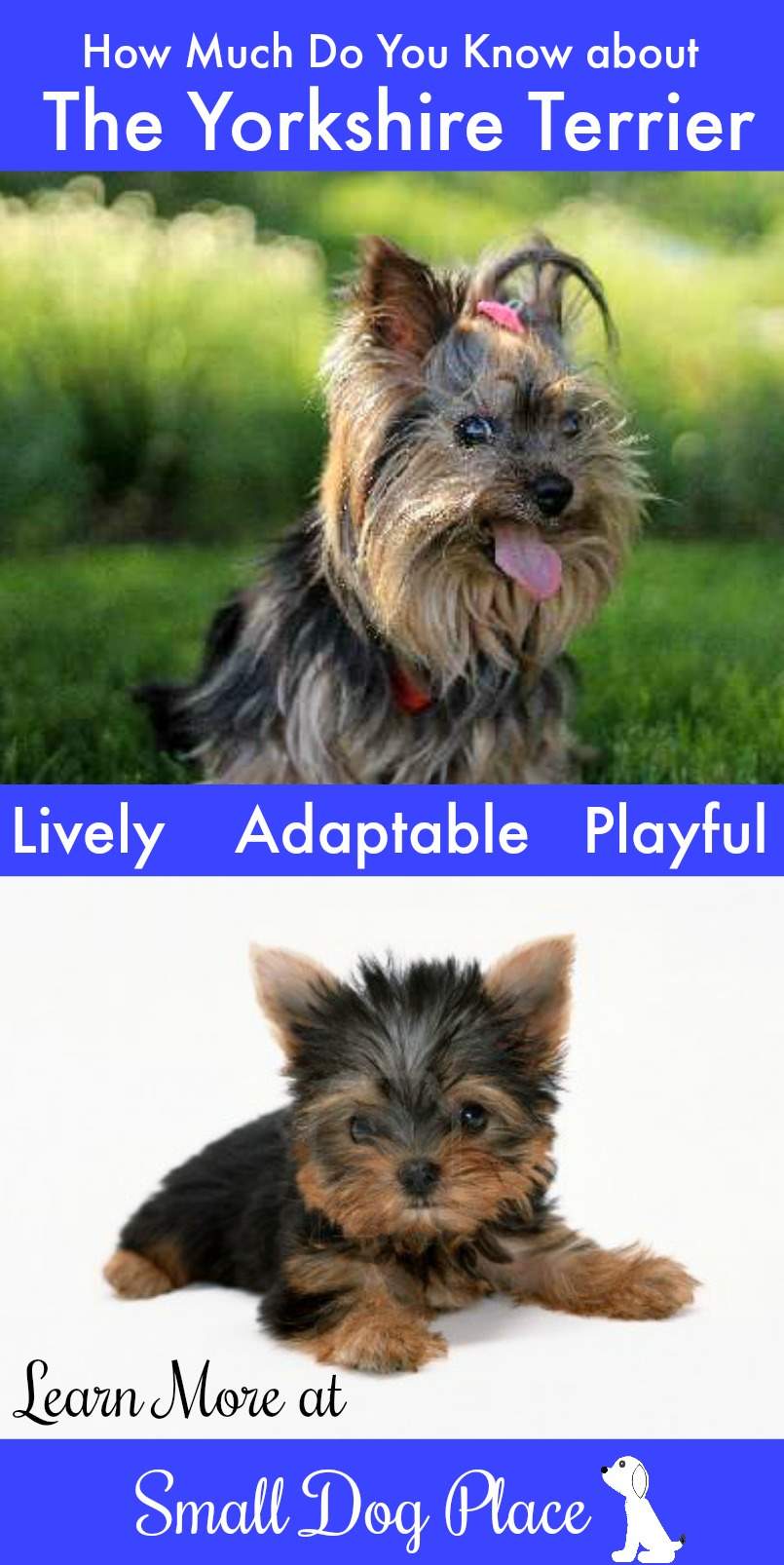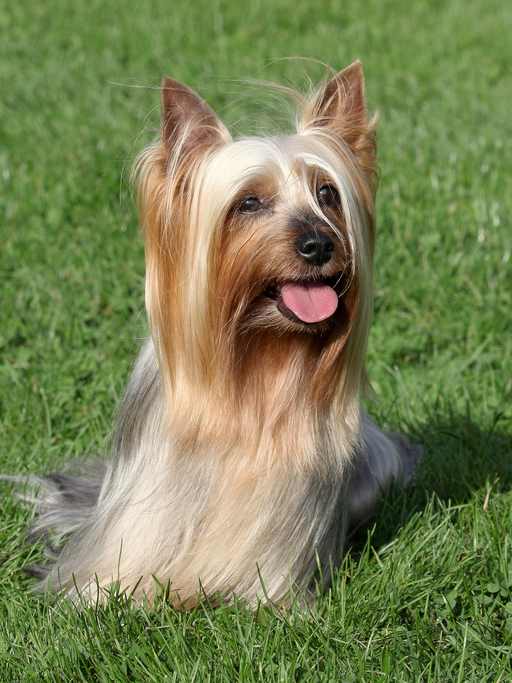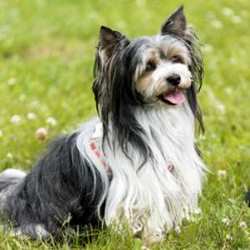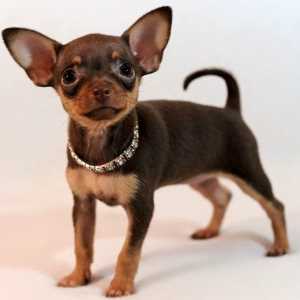- Small Dog Place Home
- A to Z Breed List
- Yorkshire Terrier
Yorkshire Terrier:Tiny Dog, BIG Attitude
by Janice Jones |Last updated 10-23-2023
People who happen to be owned by a Yorkshire Terrier are not likely to want any other type of dog. They are alert, trainable, curious, and lovable. They may be the quintessential purse dog, but what they lack in size they make up for in personality.
There is no other dog breed out there who shouts BIG ATTITUDE like the Yorkie as they are fondly called. With their silky straight coat, tiny size, bright personality, and desire to be a close companion, these dogs make great pets for a wide range of people from singles, families with older children and seniors.
They are equally happy lying on your lap as taking a long walk and will make an excellent watchdog because they never miss a beat.
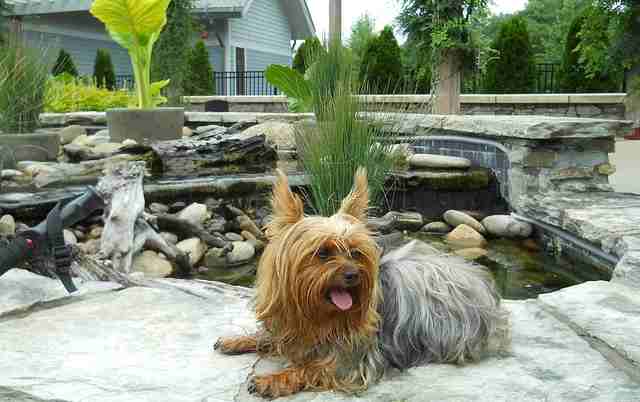 Yorkshire Terrier
Yorkshire TerrierThe Yorkshire Terrier is a small dog, generally 4 to 7 pounds with glossy fine hair that can grow to floor length. In the U.S. Dewclaws are often removed in the first few days of life, and the tail docked at the same time. In Europe, it is illegal to do these procedures.
As a toy breed, he is first and foremost a companion dog, but his terrier qualities are still present which also means he possesses a healthy prey instinct.
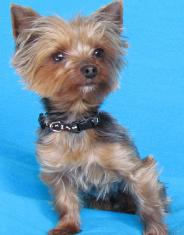
Quick Facts
Other Names Used: Yorkie
Affiliation: AKC Toy, UK: Toy
Size:
- Height: Height: 8 to 9 inches at the shoulder
- Weight: 4 to 7 pounds, sometimes larger
Coat Type: Glossy, Fine, and Silky
Colors: Black & Tan, Black & Gold, Blue & Tan, Blue & Gold
Puppies are born with black and tan coats which lighten up to a silvery color by their 3rd birthday.
Country of Origin: England
Activity Level: Moderately Active to Active
Life Expectancy: 12 to 16 Years
Good with Children: Older Children and those that have been trained how to handle small dogs
Good with other pets: Generally yes, but suspicious of strange dogs
History
There is still a debate about which breeds contributed to what we know as the modern Yorkie. Among the more likely candidates include the Toy Manchester Terrier, Maltese, Skye terrier, Dandie Dinmont Terrier and two extinct breeds, the Paisley Terrier and the Clydesdale Terrier.
It’s likely that these two extinct breeds along with the Skye terrier gave the Yorkie his long coat along with the Maltese. The Manchester contributed to the colors we see on the Yorkies today.
Even though the roots of the breed stretch back far into British history, the real story of their emergency dates to the Industrial Revolution.
People began to flock to the cities to find work, and during this time there was an influx of Scots moving to Yorkshire, England where they could work in the mills. They brought their dogs with them.
It would seem that Scottish weavers had a fondness for long coated small terriers including the Skye, Clydesdale and Paisley terriers all who ranged from about 8 to 20 pounds.
These dogs were good for keeping vermin out of the shops and homes. They bred their dogs to be smaller, fierce and feisty. During this time, there was much diversity in the breed including size and coat type. Some of the terrier’s coats were rough where others were more smooth and silky.
Yorkies proved to be great ratters in the English woolen mills. But as the time when on, they became more of a companion dog. Breeders began to select for a smaller size.
Then, in 1865, a dog emerged name Huddersfield Ben who was to become the father of the Yorkshire terrier. He only lived 6 years having met his fate at the wheels of a carriage, but he made his mark on the breed.
Two other dogs contributed to the development, and by the 1870s, the dogs were called Yorkshire Terriers in honor of where they originated. In the late 1800s, dog shows became popular, and many people began showing these dogs and keeping them as pets. Breeders worked to standardize their appearance and it when the newly formed Kennel Club was established in 1873; the Yorkshire terrier was one of the first breeds to be recognized.
By 1872, Yorkshire Terriers had made their way to the U.S., where they quickly became favorites of the upper class. By the 1950s, the breed was well established in the United States. The Nixon family shared the White House with their beloved Yorkie, Pasha.
| Traits | Rating |
|---|---|
| Playfulness | |
| Affection Level | |
| Friendliness Towards Strangers | |
| Good with Children | |
| Good with Other Dogs | |
| Good for First Time Owners | |
| Exercise Needed | |
| Ease of Training | |
| Watch Dog Ability | |
| Grooming Requirements | |
| Shedding | |
| Cold Tolerant | |
| Heat Tolerant |
Dog Breed Ratings Got You a Little Confused?
Here's a little help in understanding them
- Playfulness: Most Playful = 5 Least Playful = 1
- Affection: Most Affectionate = 5 Least Affectionate = 1
- Friendliness Towards Strangers: Most Friendly = 5 Least = 1
- Good With Children: Great= 5 Not Good with Children = 1
- Good With Dogs: Great = 5 Not Good Around Dogs = 1
- Good With First Time Owners: Fine=5 Not Appropriate = 1
- Exercise Required: Extensive Daily Exercise = 1 Minimal = 1
- Ease of Training: Very Easy = 5 Difficult = 1
- Watch Dog: Excellent Watch Dog = 5 Minimal = 1
- Grooming: Time Consuming = 5 Minimal = 1
- Shedding: Heavy Shedder = 5 Minimal = 1
- Cold Tolerance: Well Tolerated = 5 Poor Tolerance = 1
- Heat Tolerance: Well Tolerated = 5 Poor Tolerance = 1
Personality/Temperament
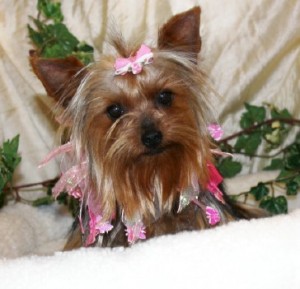
Courageous, affectionate, intelligent and fearless are words often used to describe the Yorkie’s personality. They enjoy adventures as well as snuggles, but they still retain the terrier part of their temperament, which means they can be feisty and yappy.
Each Yorkies has a distinct personality, but they generally gravitate towards one of two different personalities. Some are downright cuddly and won’t be happy unless snuggled on your lap. They are somewhat more laid back in nature but still love to play. Others are more curious and need more exercise and outdoor time.
Yorkshire Terrier dogs do well with older children and kids that have been taught how to handle tiny dogs. At seven pounds or less, they can be delicate if not handled properly.
Yorkshire Terrier Slideshow Facts

Yorkies are generally tolerant of other dogs but prefer the company of other Yorkies.
They are on the active side, so an enjoyable romp in the yard or a daily walk will help keep them from getting bored. They are also very people oriented, so leaving a Yorkie alone for hours on end is not recommended.
As an intelligent breed, Yorkies are generally easy to train. Positive praise, attention, and food rewards work well.
The major problem with this breed tends to result when people give into their cute nature and neglect their duties to teach manners. After all, it is effortless to spoil a Yorkie.
Grooming
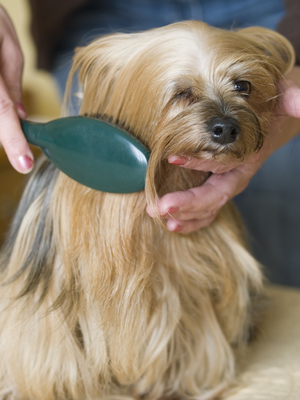 Yorkshire Terrier Grooming
Yorkshire Terrier GroomingYorkshire Terriers have a single glossy fine textured coat that does not shed much. Yorkshire Terriers require daily or every other day brushing to keep mats from forming in their long silky coats.
Many people prefer to keep their dog’s coat trimmed short for easier maintenance. Show dogs wear their hair long with a top knot tied up to keep hair out of their eyes.
A good brushing with a pin brush and then a steel comb out is usually all that is required on a daily basis. Other grooming tasks are typical of any breed: nail clipping, teeth brushing, bathing, clipping the hair from the foot pads and expressing the anal glands.
Health
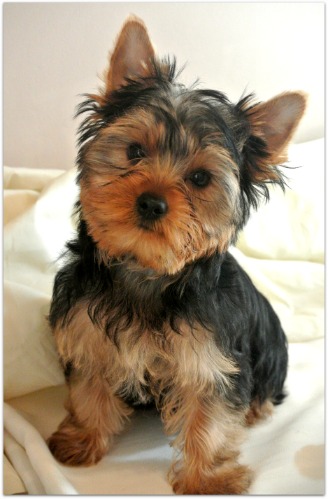
Most Yorkies live long, healthy lives, but some conditions are common to the breed, such as luxating patellas, dental issues, collapsing trachea, hypothyroidism, and Legg-Calve-Perthes disease. Some are more serious than others.
Most reputable breeders will have their breeding stock tested for some of these problems. Dental issues will need to be dealt with as they arise as there are no genetic tests that can be performed. Orthopedic problems such as Luxating Patellas and Legg-Calve Perthes Disease can be controlled to some degree through careful breeding.
Many of these diseases are common in most small breed dogs. In case you’ve read other small breed dog descriptions, you might begin to notice a pattern. So you don’t think we’re just being redundant, many small dogs suffer from the same afflictions.
Major Health Problems of Yorkshire Terriers
Portosystemic or Liver Shunt
Other Common Problems
A few other conditions that can afflict Yorkies as well as other small breed dogs include:
Retained primary teeth: Yorkie's often don't lose their baby teeth on their own and these teeth must be pulled around six or seven months. Many vets will check this when they spay or neuter and extract any baby teeth if necessary.
Hypothyroidism: If your Yorkie's thyroid isn't functioning properly, you may notice a dull coat, hair loss, and lethargy, extreme intolerance for cold weather, weight gain, and chronic skin disorders. This is treated with a thyroid supplement.
Heart disease: Some Yorkies have valves in the heart that fail to close properly, causing the blood to flow back into the chambers. Veterinarians can auscultate even small murmurs. Although uncommon, new owners should have their dog checked out by a veterinarian soon after purchase.
Bladder stones: Middle-aged Yorkies tend to get bladder “stones”. Symptoms include difficulty going to the bathroom, restricted urine flow, excessive thirst and blood in the urine. Treatment includes surgery to remove the stones.
Low blood sugar or hypoglycemia is also a problem, usually in the smallest Yorkies and puppies. If the puppy goes without food for long periods of time, they may suffer from hypoglycemia. Fortunately, this is a completely preventable issue by leaving kibble out throughout the day (Free Feeding).
Pros
- Small size, inexpensive to feed
- Good for people in apartments
- Sweet, devoted personality
- Little shedding
- Do not require a lot of exercise
Cons
- Somewhat Yappy
- Moderate amount of grooming
- Not good for families with toddlers or very small children
- People forget to train them due to their small size
Did You Know
- An extra
pound put on by your Yorkies is like adding 20 pounds to a human.
- Famous
people who have owned Yorkies include Brett Favre, Bruce Willis, Britney
Spears, Justin Timberlake, Hillary Duff and Paris Hilton.
- In 2012, the
Yorkie was the sixth most popular breed in the U.S.
- Yorkie Show Dogs always wear red bows.
Resources and References
Parent Club:
Yorkshire Terrier Club of America
National Yorkshire Terrier Rescue Organization
Yorkshire Terrier National Rescue, Inc
If you think you might like to make a Yorkshire Terrier your next best friend, I recommend that you do some further reading. The books below can be purchased directly from Amazon.
Similar Breeds
About Janice (author and voice behind this site)
Janice Jones has lived with dogs and cats for most of her life and worked as a veterinary technician for over a decade. She has also been a small-breed dog breeder and rescue advocate and holds academic training in psychology, biology, nursing, and mental health counseling. Her work focuses on helping dog owners make informed, responsible decisions rooted in experience, education, and compassion.
When not writing, reading, or researching dog-related topics, she likes to spend time with her six Shih Tzu dogs, her husband, and her family, as well as knitting and crocheting. She is also the voice behind Miracle Shih Tzu and Smart-Knit-Crocheting
Does This Article Deserve Your Thumbs Up?
We always appreciate your support and encouragement. Your thumbs up means so much to us. Please like this article.
If you find this page or any page on Small Dog Place Helpful, or useful in anyway, I'd love it if you would click the small heart found on the bottom right of each page.
You can also share or bookmark this page -- just click on the:

Free Monthly Newsletter
Sign Up for Our Free Newsletter and get our Free Gift to You.
my E-book, The Top 10 Mistakes People Make When Choosing a Dog (and how to avoid them)
